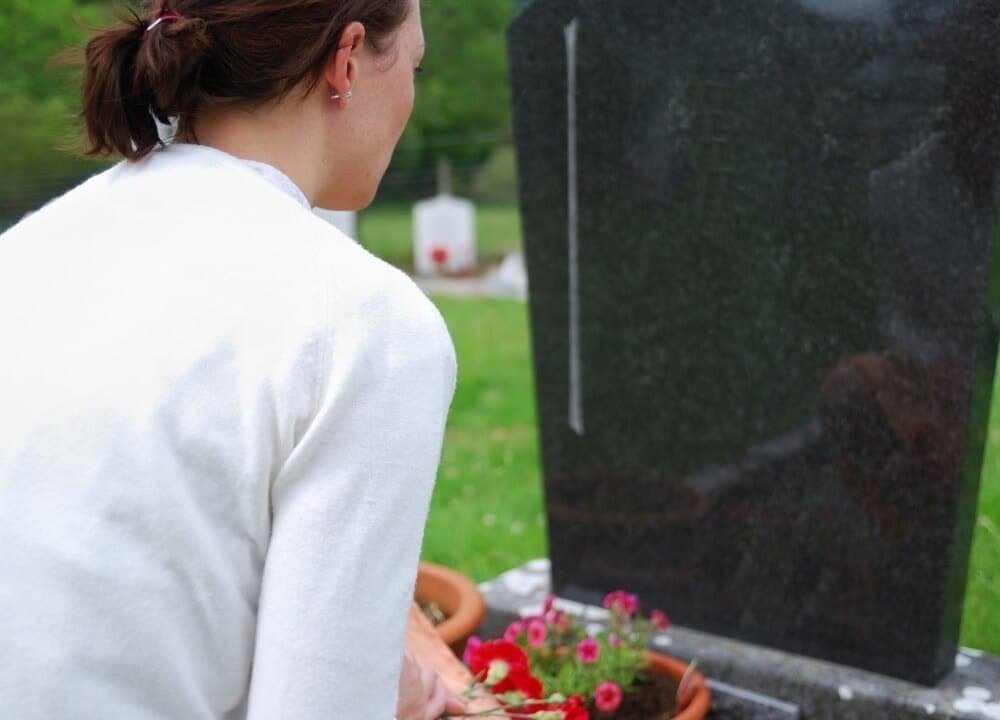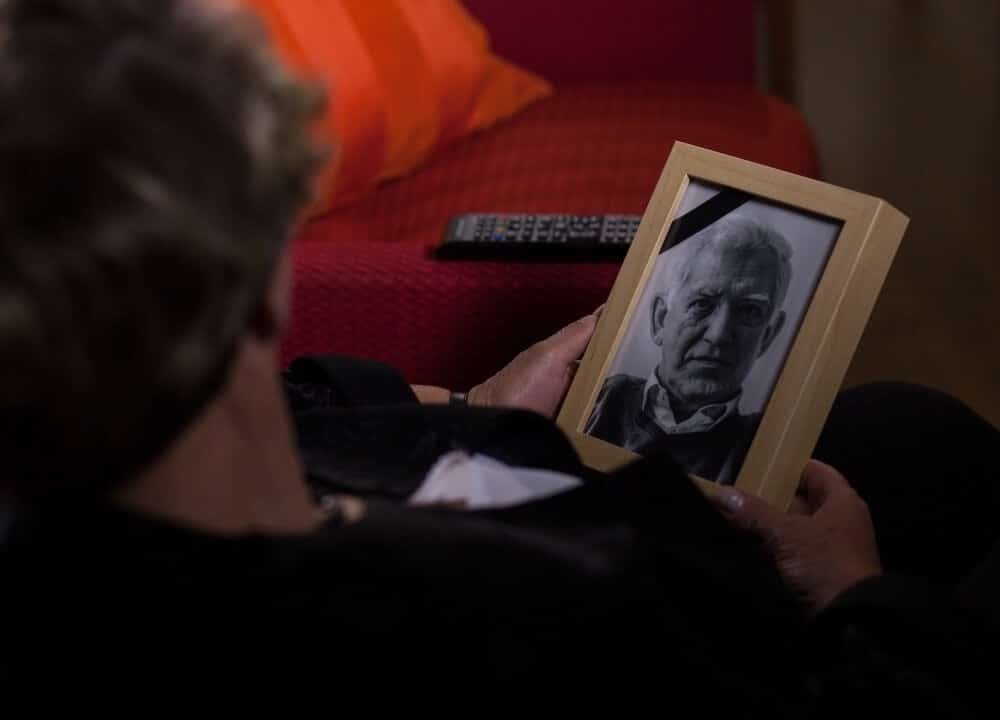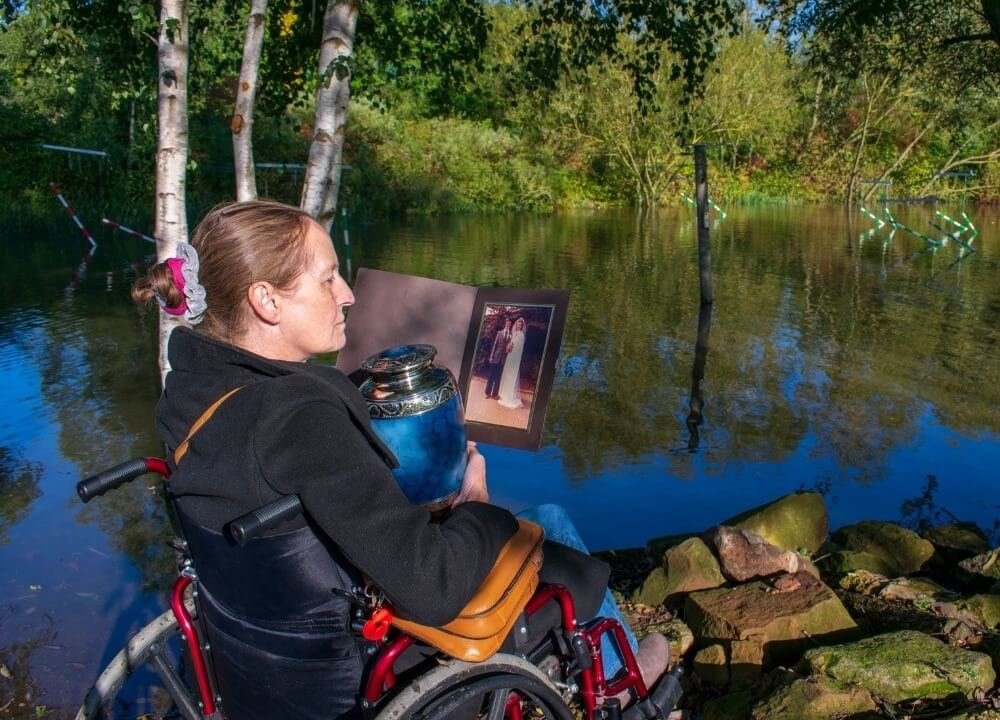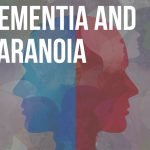If we view death as a ceasing of prospects and dementia as an even further constricting event, we might be viewing reality from behind Vaseline smeared lenses. People all have different experiences coping after the death of someone with dementia.
It could be helpful to frame dementia death with a wide gaze toward wonder and curiosity, unknowns and possibilities or loving kindness and equanimity.
Does dementia expand or limit our possibilities for grieving?
Just as some people with dementia lose cognitive capacities and need instructions of daily tasks, processes and experiences repeated, death, too, repeats with each stage of dementia.
Death can be heard echoing down the walls of the dementia corridor and reverberating in the mind-body connections.
Dementia death holds the possibility of our love being magnified beyond the resolution of one half of a hydrogen atom viewed under a microscope at the Lawrence Berkeley National Labs.
Contents
Different Dementia Death Experiences
Dementia death is not a single event, rather multiple.
Each death cascades into the next phase of dementia existence. Some have called dementia a “death of the person that once was.”
The present self is very much alive. The infiniteness of possibilities in dementia death experiences can be unified into three overlapping spaces and placed along a continuum: cognitive, emotional and physical.
Each aggregate has a corresponding type of grief. At one end of the dementia death continuum is cognitive death. Ambiguous loss can offer a comforting landing space for grappling with the complexities of these losses.
At the other end of the continuum is the physical ceasing of bodily functions – when the last breath is exhaled. Anticipatory grief may offer a lens through which to view this seemingly drawn out process.
In the middle, emotional or psychological death can be understood within the context of emotional memory. Disenfranchised grief may be a way to safely integrate the past and present.
Put differently, cognitive memories may become a watercolor display that is faintly visible to the viewer, while emotional memory is splashed in vibrant acrylic.
Cognitive Death – Ambiguous Loss

Ambiguous loss is felt in the incongruence between physical and cognitive death – here and gone.
When loss is riddled with unknowns, the bodily mechanisms that create equilibrium are unduly taxed leading to extraordinary overload and systemic exhaustion. This process can also be understood in the words of Dr. Pauline Boss, developer of ambiguous loss theory, who claims that “cognition is blocked by the ambiguity and lack of information, decisions are put on hold, and coping and grieving processes are frozen.”
When our ability to pass through grief phases, zones or stages is blocked, we remain in a reactive, repetitive and reoffending state of trauma.
Unlike an event having a succinct beginning, middle and end, episodes of psychological, spiritual and emotional trauma deliver a violent punch with the force only a professional boxer can provide. Over and over and over.
A person experiences a barrage of stimuli, visually reliving and reviewing the terror of events that flood the mind-body motherboard and shorts out circuits to other mind-body connectors.
Emotional Death – Disenfranchised Grief

Disenfranchised grief, coined by Kenneth Doka, an innovative grief expert and Professor Emeritus at Graduate School of The College of New Rochelle, a concept later expanded on by Thomas Attig, Professor Emeritus at Bowling Green State University, can be used to understand the significance of psychological or emotional losses.
Doka emphasizes the important role “hidden” losses play in our grief processes. This type of grief occurs when losses are not recognized, validated or socially sanctioned. These losses are experienced by the person with dementia in that others are not able to understand their needs, in part due to reduced verbal communication.
For a person with dementia, psychological losses are experienced with identity, agency, roles, selfhood and personhood. A person’s emotional memory gets engulfed by their cognitive deficits or diminishing mental capacity to the point of non-recognition.
Such a state of ambiguity can be confusing for people attached to Cartesian ideas of dualism. Dead or alive. Happy or sad.
Dementia is the quintessential range of human emotions and does not fit so neatly into a Western conceptualization of thriving-suffering.
Although the effects of dementia can be seen in structural, functional and neuronal shifts in the brain, emotional memory remains intact.
Fostering positive emotional experiences can ease dementia transitions. Acts of validation and integration are multiple – by self and others.
For others: listen to the meaning of what is being communicated rather than the words being spoken. Connect. Practice present moment awareness as defined by the person with dementia. For self: be here.
Practice present moment awareness. Here may be this minute, 1 hours ago, 1 year ago or some other time.
Physical Death – Anticipatory Grief

Anticipatory grief occurs as the person with dementia, family members and caregivers prepare for the final death – gone and gone. In the West, the process of mourning is an act of detachment. As some have said, dementia death is “the long goodbye.”
Liew and colleagues talk about the “pre-death grief” involved in dementia. With anticipatory grief, self and others anticipate future losses, most often in the face of life-limiting illnesses. The hope of reattaching occurs through reunification.
A universal response to loss unfolds in spiritual and religious texts and beliefs about reunification or when attempting to reunite with one who is deceased. As Willard Waller, American sociologist once said, “Other persons are present to us less from the evidence of our senses than from the activity of our imaginations.”
In many Eastern cultures, death is linked to love, and compassion to sadness.
Grief is individualized, personal and unique. Grief responses and experiences mirror the differences found in water. From the calm predictable ebb and flow seen in a neap tide to the raging waters of a rip current in the Gulf Stream to everywhere in between.
Gordon Allport, American Psychologist, reminds us of the uniqueness of individuals and his dictum can apply to grief – no one’s grief is like any other’s grief. Or we may find comfort in the Theraveda Buddhism parable of the mustard seed where Kisa learns her suffering is like everyone else’s.
Integrating Death with Life and Life with Death

A theoretical model of mourning for people with dementia must consider one’s history of losses. As Volkan suggests: “We can never purge those who have been close to us from our own history except by psychic acts damaging to our own identity.”
We grieve in the community. We are connected by love-loss. Grounded in the work of Worden’s tasks of mourning, I am offering a theoretical model of mourning in dementia death.
It can be conceptualized as a circular continuum with multidirectional movement. After assessing mastery of previous losses, acknowledging the impermanence of current cognitive-emotional-physical loss, process any additional feelings that arise, adjust to a world without the former self or the person with dementia, and acclimate to current life through full mind-body integration.
Bowlby reminds us when we resist integration the body breaks down. I would add, and the mind.
Honoring & Embracing Impermanence

A modular view of the mind suggests the conscious mind does not offer a full picture or representation of an event and our subconscious plays an active role.
This is evidenced in a study of people in a grocery store who selected one of four items (all items of which were the same) and provided explanations for their reason for selection. The conscious part of the human mind attempts to fill in information that is assumed to not have access to.
Similarly, we can borrow from research on craving and addiction where people provide explanations for their behavior that are not full portrayals of the totality of cognitive processes.
Mindfulness meditation can offer a moderating effect, by making less nuanced our choices in day to day life. Further, mindfulness informed grieving may soften the jagged edges of dementia death.
By engaging in mindfulness practices, we are not pulled into a dichotomous trap of this or that, yes or no. Tolstoy reminds us of the view of grief as an expansion of love. Kumar invites a perspective of grief as a self-awakening journey.
Neuroscientist Judson Brewer promulgates the importance of a curious mind. Tara Brach, an American psychologist and founder of the Insight Meditation Community developed a method of RAIN (recognize – allow – investigate co– nurture) to interrupt the concept of permanence.
Adopting an objective observer’s perspective of loss and death may lead to less suffering.
At the same time, Robert Wright, author of Why Buddhism is True, suggests, “the category we put [events into then] shapes the perception of its essence. There is always an implied narrative.”
American psychologist, Paul Bloom concurs, “We always experience something under some view as an instance of a category.” Awareness is key.
A combination of meditation, breath awareness, and a curious mind may be just the agents needed to remove some of the Vaseline from the lenses of our glasses.
With a clear view, we might embrace the quirky space between here and gone. We just might move closer to appreciating the beauty in the uncertain space between dementia life and dementia death.
::
Sources
Attig, T. (2004). Disenfranchised grief revisited: Discounting hope and love. OMEGA–Journal of Death and Dying, 49, 197–215. doi:10.2190/P4TT-J3BF-KFDR-5JB1
AZO Nano. Accessed at: https://www.azonano.com/
Boss, P. (2006) Loss, Trauma and Resilience: Therapeutic Work With Ambiguous Loss. W. W. Norton & Company: New York.
Blandin, K., & Pepin, R. (2017). Dementia grief: A theoretical model of a unique grief experience. Dementia (London, England), 16(1), 67–78. Doi: 10.1177/1471301215581081
Bowlby, J. (1980). Attachment and loss: Loss, sadness, and depression (Vol. II). New York, NY: Basic Books.
Csikszentmihalyi, M. (1988). The flow experience and its significance for human psychology. Cambridge: Cambridge University Press.
de Silva, P. (2014). An Introduction to Buddhist Psychology and Counseling: Pathways to Mindfulness-based Therapies, 5th Ed. Palgrave Macmillan: Hampshire, UK.
Doka, K. J. (2002). Disenfranchised grief: New directions, challenges and strategies for practice. Champaign, Il: Research Press.
Liew, T. M., Yap, P., Luo, N., Hia, S. B., Koh, G. C., & Tai, B. C. (2018). Detecting pre-death grief in family caregivers of persons with dementia: measurement equivalence of the Mandarin-Chinese version of Marwit-Meuser caregiver grief inventory. BMC geriatrics, 18(1), 114. https://doi.org/10.1186/s12877-018-0804-5
Muñoz, J. E.. (2009). Cruising Utopia: The Then and There of Queer Futurity. New York: New York University Press, 1.
Nadeau, J. W. (2008). Meaning-making in bereaved families: Assessment, intervention, and future research. In M. S. Stroebe, R. O. Hansson, H. Schut, & W. Stroebe (Eds.), Handbook of bereavement research and practice: Advances in theory and intervention (p. 511–530). American Psychological Association
Parkes, C.M., Laungani, P. Young, W. (2015). Death and Bereavement Across Cultures: 2nd Ed. Routledge: New York.
Rando, T.A.. (2000). Clinical dimensions of anticipatory mourning: Theory and practice in working with the dying, their loved ones and their caregivers. Champaign, Il: Research Press.
van der Kolk B. (2000). Posttraumatic stress disorder and the nature of trauma. Dialogues in clinical neuroscience, 2(1), 7–22.
Vulcan, V. (1972). The linking objects of pathological mourners. Archives of general psychiatry, 27, 215-221 doi: 10.1001/archpsych.1972.01750260061009
Waller, W. (1938). The Family: A Dynamic Interpretation. New York: Cordon Co., p. 20.
Worden, J. W. (2018). Grief counseling and grief therapy: A handbook for the mental health practitioner (5th ed.). Springer Publishing Co. https://doi.org/10.1891/9780826134752
Worden, J. W. (1976). Personal death awareness. Englewood Cliffs, NJ: Prentice Hall.
Wright, R. (2017). Why Buddhism is True: The Science and Philosophy of Meditation and Enlightenment Simon and Schuster: New York.







